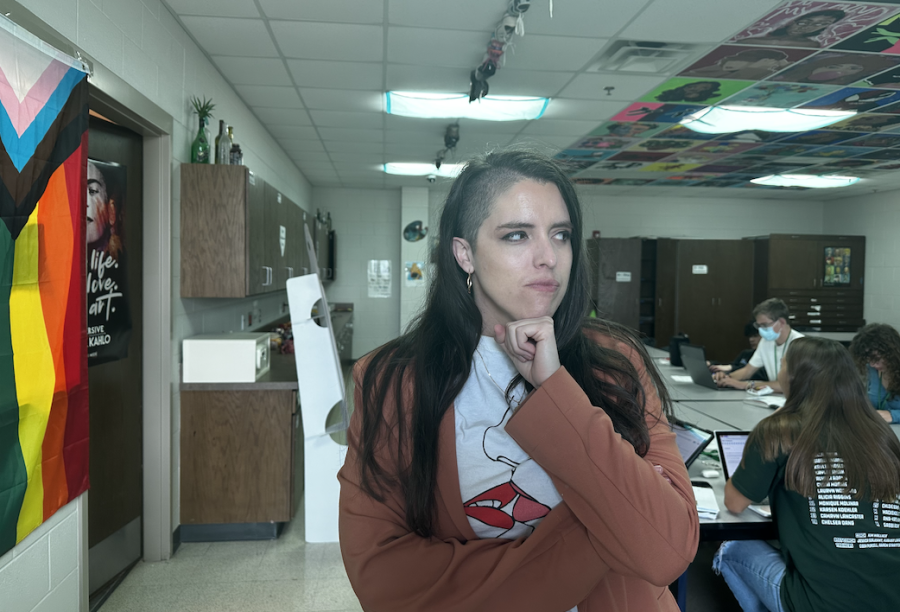Bailey’s Beacon
In heeled boots that clack with her every step, Stacy Bailey makes her way into her classroom. As she sits down at her desk, she is already creating art. Her passions reveal themselves before she even begins to speak, through her ink-stained fingertips, iconic Beyonce T-shirt, and paint-splotched trousers. Every freedom she has to express herself through these things gives her a sense of victory, especially considering the harsh environments she had to grow up through.
In the past decade, Bailey has rarely been afraid to voice her opinions and experience every thing she doesn’t already know. On nature hikes she makes sure to run her fingers over every interesting rock. She examines footsteps in the gravel and etchings on trees. She questions all she doesn’t understand. But, she wasn’t always able to be like this. Birthed to a family of strict beliefs and norms, she grew up in a unique household. Her parents only showed her a black and white view of society, limiting her worldliness and imagination.
“Most of my childhood I was scared– everything. I was brought up in a really controlled environment. And I was taught to fear everything that wasn’t my family,” Bailey said. “We were not allowed to have an imagination and that was seen as a bad word in my house.”
For years she blindly followed this path paved by who were meant to be the two most important adults in her life. Although her parents didn’t understand her, their parents did. It was through her grandparents that she gained perspective on things. To this day Bailey continues to wonder if her grandfather shaped her individuality or if she had been like him all along.

“I’m the most like my grandpa out of anyone. The silliness, the bluntness, the darkness, the ability to be funny and dark at the same time,” said Bailey. “He also observed the world like I do. It’s hard to know if I observe the world like him, because I witnessed him my whole life, or if that’s just intrinsically who I am.”
Despite her closeness to him, it was her grandmother that gave her direction in life. She gave Bailey the thing she wanted most during her difficult teenage years, as she battled mental illnesses and an array of issues: light. She gave her granddaughter someone to look up to and believe in. Not only that, but she showed a young girl how much love and empathy she had in herself. Years later, it made sense to Bailey to also become a teacher like her beloved role model.
“Most of my life I was modeling after my granny, she loved children. And when I knew I was going to be a teacher, I would pray, I just wanted kids to feel as loved as I knew she could love them. I had this compassion. I knew I had a capacity for love. And I prayed a lot and I wanted to be able to be like her and to be like the teachers that I had. So that became like a goal,” Bailey said.
Fear settled in for her when in 2001, her grandmother got sick from colon cancer. She grew weak and fragile as each day passed, and like she was taught, Bailey prayed for her grandmother.
“I always believed that if you prayed enough, or that if you had faith that God would do these things for you and and we were all praying and I had no doubt in my mind that she was going to be fine,” she said.
This mindset changed when at 15 years old Bailey had to witness cancer take her grandmother from her.
“I just was 100% certain I was going to witness a miracle until she actually died. And I’ve never felt so betrayed in my life than that moment. Like, complete shock. First of all, I had never seen a dead person. That’s always traumatic for anyone, and she was the person I love the most,” Bailey said.
For her, this was a turning point. This event was the beginning of other deaths in her life, including her mother and grandfather. It was also when she stopped taking the role of the naive, obedient daughter and started to question her beliefs and everything she was taught.
“My voice just came out of me at that moment. I couldn’t stop it from coming out at that point. I was so hurt. I don’t know. I’ve never been hurt exactly like that– anger and all these feelings I hadn’t really had before. Even though I didn’t feel allowed to have them, I was having these emotions.”
She experimented with expressing these emotions in various ways. Mostly, she found herself through writing and art.
“Most of my expressions were very intense and very sad and dark. And my art teacher in high school would give me sketchbooks and I would just fill them up. And that’s when I think I got obsessed with expression and expressing myself in general,” Bailey said.
Over the years, she has grown into this life of expression. She has filled up dozens and dozens of journals, filled up walls of her house with handmade pieces, and inspired children of all ages to express themselves similarly. Bailey has continued to display it through her career, her interactions, and her art. When she traces these bits of light in her life back, they all connect to her grandparents.
“It all came from them,” Bailey said. “Any positive thing in my life comes from them.”


